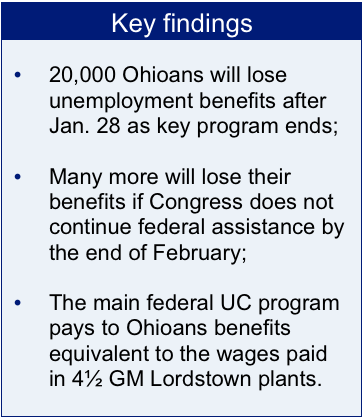
20,000 Ohioans will lose unemployment benefits this month
January 05, 2012
20,000 Ohioans will lose unemployment benefits this month
January 05, 2012
Download PDFOhio House approves extension“Congress should extend federal benefits to help struggling families, but also to help Ohio emerge from the weak economy more quickly." Zach Schiller, research director
Many more to lose benefits without Congressional action
 Some 20,000 Ohioans will lose their unemployment compensation benefits after January 28 when a program supporting the long-term unemployed ends. These are just the first of a bigger wave that will lose their benefits over coming months if Congress does not act to extend federal support before the end of February.
Some 20,000 Ohioans will lose their unemployment compensation benefits after January 28 when a program supporting the long-term unemployed ends. These are just the first of a bigger wave that will lose their benefits over coming months if Congress does not act to extend federal support before the end of February.
“Congress should extend federal benefits to help struggling families, but also to help Ohio emerge from the weak economy more quickly,” said Zach Schiller, research director at Policy Matters Ohio.
Congress voted in December to continue for two months the Emergency Unemployment Compensation (EUC) program, which currently covers 2.9 million unemployed workers across the country and more than 80,000 Ohioans.
The 20,000 Ohio workers affected by the January 28 cut-off have been receiving benefits under a different program. They have been laid off even longer – at least a year and a half – and have been receiving benefits through the Extended Benefits (EB) program, a joint federal-state effort dating back to the 1970s. Separate from EUC, it provides 13 to 20 weeks of additional benefits if a state has a high unemployment rate and that rate over a three-month period is 10 percent higher than it was in the same period over any of the past three years. Since Ohio’s unemployment rate is over 8 percent, workers here have qualified for 20 additional weeks of benefits. This program has been fully paid by the federal government for all private-sector workers since the American Recovery and Reinvestment Act in 2009, and is currently funded through February.
The Ohio General Assembly acted last year to make sure that unemployed Ohioans would continue to qualify by extending the “lookback” period to three years from two, as allowed under federal law (that means the unemployment rate over a three-month period has to be 10 percent higher than it was over the comparable period in one of the last three years). However, that state law was effective through December 31, not as long as federal funding lasts, so benefits will end, as the program prescribes, a few weeks later. Even if federal support were extended and the state changed its law, Ohio likely would no longer qualify for this program in March, and benefits likely would end in early April, according to the National Employment Law Project. That’s because, at its current level, Ohio’s unemployment rate – though very high, at 8.5 percent – soon won’t be 10 percent above its rate three years ago.
“While the prospects for helping the workers in the Extended Benefits program are more limited, Congress can and should still act to help the larger group of workers in the Emergency Unemployment Compensation program,” Schiller said.
It is good news that unemployment is slightly lower than it has been, but it still leaves nearly half a million Ohioans unemployed. Ohio, like most of the nation, continues to be gripped by an unemployment crisis. Congress has approved additional benefits in each downturn since the 1950s, and at no time did it end such benefits when the national unemployment rate was above 7.2 percent. In November, the U.S. unemployment rate was 8.6 percent. Nationally, there is only one job for each 4.3 openings, according to the most recent survey by the U.S. Bureau of Labor Statistics.
Long-term unemployment remains especially severe, with 5.7 million workers – 43 percent of those without jobs – unemployed for 27 weeks or more. And some of the progress in reducing unemployment, both in Ohio and nationally, has come because workers are dropping out of the labor force, so they are no longer counted as unemployed (See www.policymattersohio.org/job-watch-dec2011). Overall, despite an increase in employment over the past two years, Ohio has lost more than 307,000 jobs since the recession started in December 2007.
“The end of these benefits underscores the need for Congress to keep EUC benefits flowing to long-term jobless,” said Schiller. The EUC program offers up to 53 weeks of additional benefits beyond the 26 weeks of regular state benefits. The amount paid to unemployed Ohioans through the first 10 months of 2011 under the EUC program amounted to $1.38 billion. On an annual basis, that is the equivalent of more than four and a half times the payroll of the General Motors Lordstown Complex. Thus, quite apart from the benefit to individuals and their families of these benefits, they are also an important contributor to the state economy.
Recently, the share of unemployed Ohioans receiving regular state benefits, which last up to 26 weeks, has sunk to at least a 35-year low. During the third quarter of 2011, less than 19 percent of unemployed Ohioans received regular state UC benefits. According to recent claims figures from the Ohio Department of Job & Family Services, the end of federally-supported benefits would mean that almost half of those Ohioans currently receiving benefits would be cut off.
Both state and federal UC benefits average less than $300 a week in Ohio, a modest sum. Yet according to the U.S. Census Bureau, in 2010 unemployment compensation kept 3.2 million people out of poverty in the country. This crucial part of the safety net must be maintained.
-30-
Photo Gallery
1 of 22